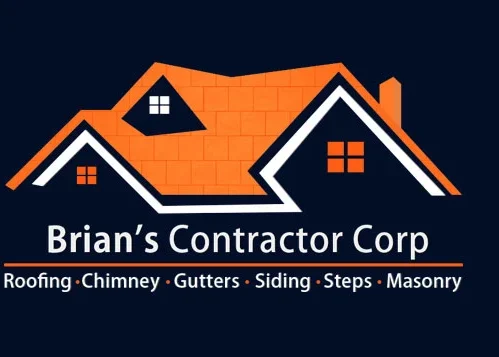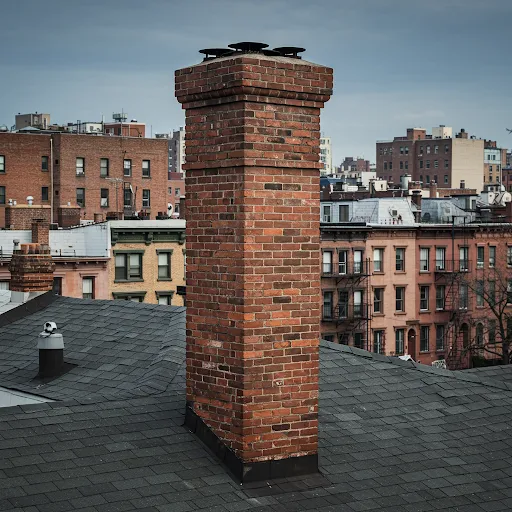
When it comes to protecting your home in New York, Brian’s Corp is the trusted expert you can rely on to keep things safe, efficient, and looking their best. From historic brownstones in Brooklyn to modern homes in Queens, chimneys are a crucial part of keeping New York homes healthy and comfortable. If you’ve ever wondered what is chimney, it’s the structure that safely vents smoke, gases, and heat from your home, playing a vital role in maintaining indoor air quality and safety.
You’ve probably noticed a brick or metal structure sticking out of the roof — that’s the chimney. But it’s more than just a familiar sight; it’s a carefully designed system that plays a critical role in your home’s safety and comfort.
Whether you’re cozying up to a fireplace in the winter or simply keeping your heating system running smoothly, the chimney is the essential part that safely releases the byproducts of combustion. As a homeowner in New York, understanding how a chimney is built, how it works, and the different types available is key to ensuring safety, efficiency, and long-term protection for your home.
In this guide, we’ll walk you through everything you need to know about chimneys — how they function, the parts that make them work, the different styles you might encounter, and why proper maintenance is so important.
Whether you’re buying a classic brownstone, renovating a suburban home, or just want peace of mind, this article will give you the knowledge to make smart, informed decisions about your chimney.
What Is a Chimney?
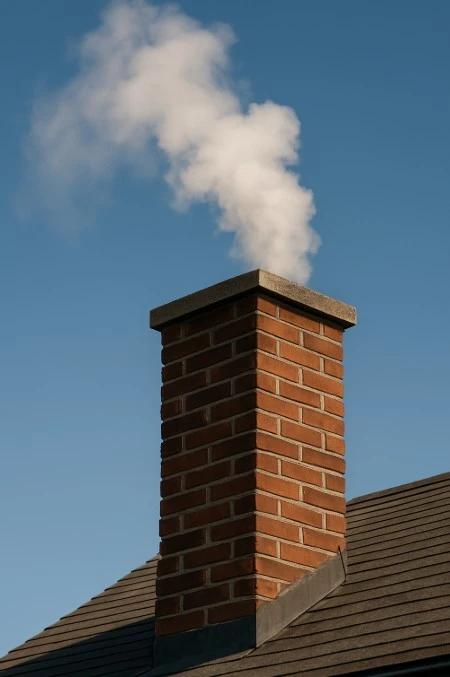
Think of a chimney like your home’s way of breathing. It’s a pipe or structure that lets smoke, gases, and heat escape safely outside when you use your fireplace, furnace, water heater, or boiler. For New York homeowners, especially with all our older houses and apartment buildings, having a working chimney isn’t just nice — it’s a must.
Here’s what a chimney does
- Gets Smoke and Gases Out: When you burn wood or fuel, it creates smoke and gases like carbon monoxide. The chimney gives all that bad stuff a way to leave your home, keeping the air inside safe to breathe.
- Helps Prevent House Fires: By keeping heat, flames, and sparks contained, a chimney helps protect your home from fires.
- Makes Heating Work Better: A good chimney creates a strong pull of air (called a draft), which helps your fire burn hotter and more efficiently.
- Adds Charm to Your Home: Around New York, chimneys aren’t just useful — they’re part of a home’s character. Whether it’s a classic Brooklyn brownstone or a cozy Queens house, a chimney adds to that welcoming, lived-in feel.
Chimneys have been around forever. Back in the day, people just built fires in the middle of a room and hoped the smoke found its way out through a hole in the roof. Later on, in castles and big houses, brick chimneys became a big deal — not just for getting rid of smoke but also for looking impressive.
When cities like New York started booming, metal chimneys became common because they were cheaper and quicker to build. These days, chimneys come in all shapes, sizes, and styles — but they’re still doing the same important job: keeping your home safe and your air clean.
Why Chimneys Are So Important for Buildings
Even though a chimney looks simple, it does a lot to keep a building safe, comfortable, and working well.
Let’s look closer at these important things
Getting Rid of Smoke and Gases
- Chimneys safely remove harmful substances like smoke, carbon monoxide, water vapor, and other gases produced by burning materials.
- Properly functioning chimneys prevent the dangerous buildup of gases inside the home.
- Carbon monoxide is especially hazardous, as it is odorless and can be fatal.
Keeping You Safe from Fire
- Chimneys protect the home from fire by acting as a barrier between flames and the rest of the house.
- Made of fire-resistant materials like brick, stone, or metal, they channel hot gases and sparks safely away.
- The chimney’s airflow helps prevent sparks from landing on flammable materials inside the house.
Helping Heating Work Better
- Chimneys create a “draft” by drawing in fresh air, which provides oxygen for the fire to burn efficiently.
- A well-maintained chimney improves heat output and reduces fuel consumption.
- Blocked or poorly designed chimneys can lead to poor airflow, making fires burn inefficiently, costing more in fuel.
Adding to How a Building Looks
- Chimneys contribute to a building’s aesthetic, with styles ranging from traditional brick to modern metal pipes.
- Architects design chimneys to complement a building’s overall style, adding a cozy, elegant, or minimalist feel.
How a Chimney Works?
A chimney works well because of some basic science, mostly something called the “stack effect.”
What the Stack Effect Is
- The stack effect, or chimney effect, occurs when air moves in and out of a building or chimney due to differences in air temperature and moisture.
- Hot gases inside the chimney are lighter than the cooler air outside, causing the cooler air at the bottom to push the hot gases upward and out.
How Temperature and Air Pressure Play a Role
- A larger temperature difference between hot gases and cooler outside air creates a stronger stack effect and draft (air pull).
- Fire heats the air, making it lighter, while the cooler air outside creates lower pressure at the bottom of the chimney, pushing hot gases and smoke upward.
How Tall and Wide a Chimney Affects Its Function
- Chimney Height: Taller chimneys generally create a stronger draft due to a larger column of cool air pushing on warm gases below. However, if too tall, gases may cool too much before exiting, weakening the draft.
- Chimney Width: A narrow chimney can restrict airflow, causing a weak draft or blockages. A chimney that’s too wide may cause the hot gases to cool too quickly, weakening the stack effect.
- The ideal chimney size depends on the heater’s size and heat output for optimal performance.
Natural Draft vs. Mechanical Draft Chimneys
Most chimneys in homes use natural draft, which works with the science we just talked about. But sometimes, they use mechanical draft systems.
Natural Draft
Most common in homes, relying on the temperature difference between gases inside and outside air, along with chimney height and width.
Simple design, no electricity needed, and generally works well when properly designed and maintained.
Mechanical Draft
Uses fans to assist in moving air, typically used when natural draft isn’t strong enough (e.g., with specific heaters, complex air systems, or challenging weather).
Two main types
Induced Draft: A fan at the top of the chimney pulls gases out.
Forced Draft: A fan near the heater pushes air into it, sending gases up the chimney.
Here’s a quick look at how they compare:
Feature | Natural Draft | Mechanical Draft |
How it Works | Uses temperature and pressure differences | Uses fans |
How Complex | Simpler | More complex, needs electricity |
How Reliable | Usually reliable if designed well | Can be affected by power outages or fan problems |
Cost | Lower to buy and run | Higher to buy and run (electricity) |
Upkeep | Usually less upkeep needed | Needs regular fan upkeep |
How Flexible | Good for many homes | Useful in specific situations with weak draft |
The Main Parts of a Chimney
A chimney isn’t just one thing; it’s a group of important parts that all work together.
Flue
- The internal tunnel or pipe that carries smoke and gases up and out of the chimney.
- It can be made from brick, tile, or metal.
- Its size and shape are important for creating a good draft.
Flue Liner
- A protective layer inside the flue, made of clay tiles, metal, or concrete.
- Holds in harmful substances: Prevents gases and creosote from soaking into the chimney.
- Improves draft: A smooth, properly sized liner enhances airflow.
- Fire safety: Keeps heat and flames contained, reducing fire risk.
Chimney Crown and Cap
- Chimney Crown: The concrete or stone top of the chimney, preventing water damage.
- Chimney Cap: A cover that sits on top of the flue with several purposes:
- Stops water: Prevents rain and snow from damaging the flue.
- Keeps things out: Blocks debris and animals from obstructing the flue.
- Catches sparks: Some caps have screens to prevent sparks from escaping.
- Stops water: Prevents rain and snow from damaging the flue.
Smoke Chamber and Smoke Shelf
- Smoke Chamber: Located above the fireplace, it narrows towards the flue, helping direct smoke upward and improving draft.
- Smoke Shelf: A ledge at the bottom of the smoke chamber that catches debris and helps even out pressure, aiding the draft.
Damper
- A movable plate inside the flue, typically above the smoke chamber
- Opens to allow smoke and gases to exit during a fire.
- Closes to seal the flue when not in use, preventing cold air from entering and warm air from escaping, which conserves energy.
Firebox
- The area where the fire burns, typically made of heat-resistant bricks.
- Designed to hold the fire and direct heat up towards the smoke chamber and flue.
Chase Cover (for Factory-Made Chimneys)
- A metal plate on top of a factory-made chimney’s wooden or metal “chase.”
- Serves the same function as a chimney crown, protecting the interior from water damage.
Imagine cutting a traditional brick chimney in half. At the bottom, you’d see the firebox, the strong place where the fire burns. Above it, the walls curve in to make the smoke chamber, which leads to a straight pipe – the flue. Inside the flue, there’s a smooth lining, the flue liner, protecting the brick. At the bottom of the smoke chamber, there’s a small ledge, the smoke shelf. Just above the smoke chamber, there’s a damper that can move. As the chimney goes up above the roof, the brick part is covered by a sloped chimney crown, and on top of the flue opening is a chimney cap with a screen.
Now, picture a chimney made in a factory. It has a metal pipe for the flue, often with two or three layers to keep heat in, going straight up. This pipe is usually inside a decorative box made of wood or metal. At the top of the box, a flat metal chase cover seals it, and a chimney cap is on top of the metal flue pipe.
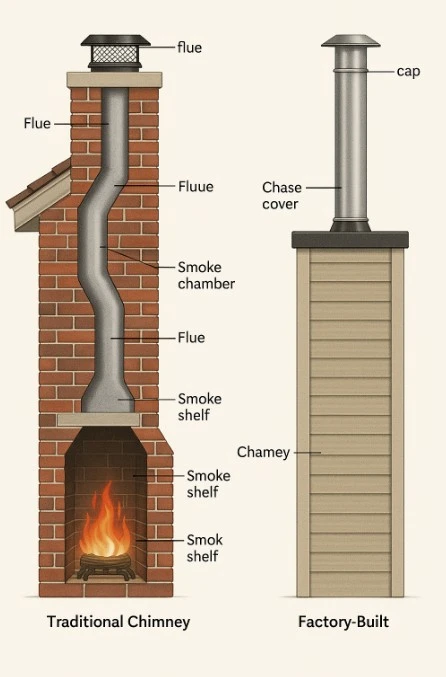
Different Types of Chimneys – Choosing the Right One
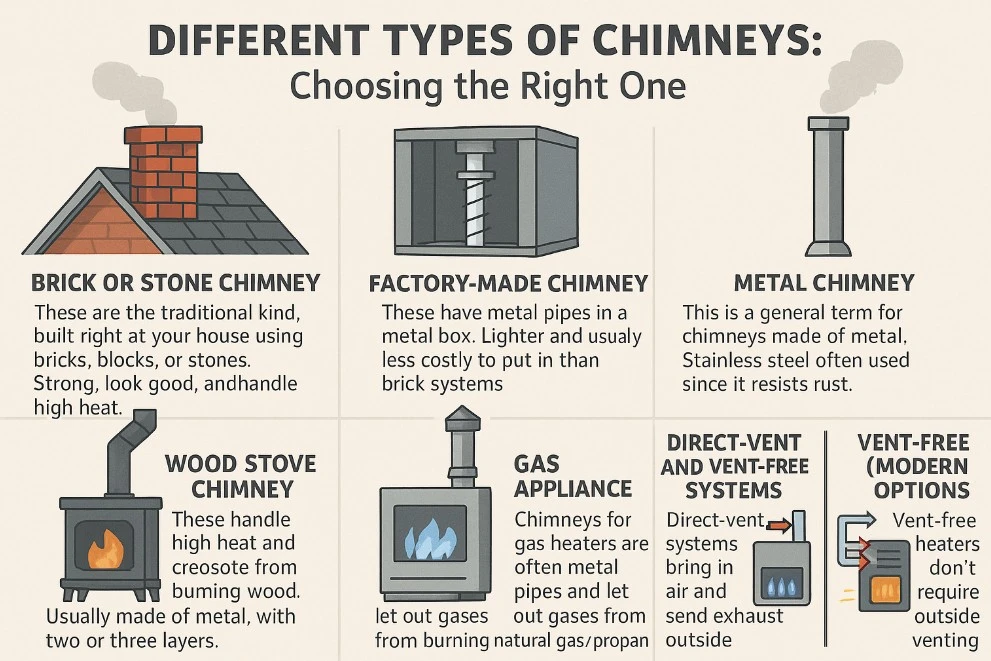
The kind of chimney you need depends on a few things, like what kind of heater you’re using, how your house looks, how much money you want to spend, and the rules in your area.
Brick or Stone Chimneys
- Built on-site using bricks, blocks, or stones with mortar.
- Strong, visually appealing, and can withstand high heat.
- More expensive to build and require a strong foundation due to their weight.
- Typically need a flue liner.
Factory-Made Chimneys
- Pre-manufactured with metal pipes (often insulated) inside a metal box.
- Lighter and more affordable than brick chimneys.
- Designed for specific heaters and must be installed according to the manufacturer’s guidelines.
Metal Chimneys
- General term for chimneys made of metal, including factory-made systems and single metal pipes.
- Commonly used for wood stoves or industrial settings.
- Stainless steel is preferred due to its rust resistance.
Wood Stove Chimneys
- Designed to handle high heat and creosote buildup from burning wood.
- Typically metal with two or three layers, with specific safety ratings.
Gas Appliance Chimneys
- Built to vent gases from burning natural gas or propane.
- Often use metal pipes, available in single or double-walled options based on the heater and regulations.
- Typically do not get as hot as wood-burning systems.
Direct-Vent and Vent-Free Systems (Modern Options)
- Direct-Vent: Brings in air from outside and expels exhaust gases outside via a sealed pipe, eliminating the need for a traditional chimney.
- Vent-Free: Heaters that burn fuel cleanly without the need for any venting, though there are usually regulations due to indoor air quality concerns.
Which Type Fits Where
- Older houses often have brick chimneys that match their style.
- Newer houses might use factory-made chimneys because they’re easier to install and cost less.
- Wood stoves need metal chimneys that are specifically made for them.
- Gas heaters have different approved ways to vent, including metal chimneys and direct-vent systems.
- Vent-free systems are usually used for extra heat in places where the rules allow them.
How Chimney Ventilation Systems Work
Good chimney ventilation is super important for any heater that uses a chimney to work safely and well.
- Why Good Ventilation Matters: If a chimney ventilates well, all the bad stuff from burning goes out of the building, so dangerous gases like carbon monoxide don’t build up. It also helps the fire burn better by giving it the air it needs.
- How Ventilation Affects Energy and Safety: A chimney that’s working well helps save energy because the fire burns better, giving you more heat with less fuel. For safety, good ventilation lowers the risk of carbon monoxide poisoning and chimney fires caused by creosote or blockages.
Common Chimney Problems and How to Avoid Them
Even though chimneys are built to last, they can have problems over time. Knowing about these problems and taking steps to prevent them is key to keeping your chimney safe and working right.
Creosote Buildup
- A sticky, tar-like substance that accumulates in the flue when wood doesn’t burn completely.
- It can easily catch fire, leading to dangerous chimney fires.
- How to Avoid It:
- Burn dry, aged wood.
- Ensure the damper is fully open for proper airflow.
- Have the chimney professionally cleaned regularly with chimney sweep services.
Chimney Leaks
- Water can enter through cracks in the brickwork, damaged chimney crowns, or faulty caps.
- Leaks can cause significant damage, including crumbling brick, rusted metal parts, and damage to surrounding walls and ceilings.
- How to Avoid It:
- Keep the chimney crown in good condition and properly sealed.
- Install a chimney cap.
- Repair any cracks or damage to the brickwork promptly with expert chimney repair services.
Blockages from Debris or Animals
- Birds, squirrels, leaves, and other debris can block the chimney, affecting airflow and causing backdrafts, which can also be a fire risk.
- How to Avoid It:
- Install a chimney cap with a screen to block animals and debris.
Damage from Weather or Lack of Maintenance
- Exposure to weather, freezing/thawing cycles, and lack of upkeep can cause damage, leading to cracked bricks and mortar and weakening the chimney.
- This damage can allow water to enter and cause further problems.
- How to Avoid It:
- Schedule regular inspections to address small issues before they escalate.
- Ensure water drains away from the chimney base and fix cracks or crumbling mortar quickly. For severely damaged chimneys, consider chimney rebuild solutions.
Chimney Safety – Why Taking Care of It Matters
We need to say how important it is to take care of your chimney regularly. It’s not just about keeping it looking nice; it’s about keeping you and your family safe.
Dangers of Carbon Monoxide Poisoning
- What is Carbon Monoxide (CO)?
- CO is an odorless, colorless gas that can be deadly. It forms when fuels like wood, natural gas, propane, or oil don’t burn completely.
- If your chimney is blocked or doesn’t have good airflow, CO can build up inside your home.
- Signs of CO Poisoning:
- Early symptoms resemble the flu, including headaches, dizziness, confusion, and nausea.
- Prolonged exposure can cause serious health problems and even death.
- How to Prevent CO Poisoning:
- Install carbon monoxide detectors on every floor of your house, especially near bedrooms.
- Ensure your chimney is regularly inspected and cleaned to prevent blockages and ensure proper airflow.
- Never use a fuel-burning heater if there’s an issue with the chimney.
Fire Risks from Neglected Chimneys
- Creosote Buildup
- Creosote in wood-burning chimneys is highly flammable. Even small amounts can catch fire when temperatures rise, leading to a dangerous chimney fire that could spread to your home.
- Blockages from debris or animals can obstruct airflow, causing overheating or nearby fires.
- How to Prevent Chimney Fires:
- Burn dry, seasoned wood and make sure your chimney has proper airflow.
- Regularly clean your chimney to remove creosote buildup.
- Have your chimney professionally inspected annually to catch any potential fire hazards.
Why Regular Cleaning and Checkups Are Important
- Routine Maintenance
- Regular cleaning removes creosote, soot, and debris, greatly reducing the risk of chimney fires and CO buildup.
- Annual checkups by a trained professional can identify issues like cracks, leaks, or blockages early on, allowing you to fix them before they become dangerous or costly.
- Think of it as a health check for a critical system in your home—prevention is always cheaper and safer than repair after an issue arises.
Choosing the Right Chimney Expert – What to Look For
When it comes to something as important as your chimney, you want to be sure you’re working with someone who knows what they’re doing and is trustworthy. Here’s what you should look for:
- Important Certifications (like CSIA): Groups like the Chimney Safety Institute of America (CSIA) give certifications to chimney sweeps and technicians who have shown they know a lot about chimneys. Hiring someone with a CSIA certification gives you confidence that they’ve had good training and follow the best ways of doing things in the industry. Look for these credentials when you’re choosing someone to work on your chimney.
- Questions to Ask Before Hiring: Don’t be afraid to ask potential contractors important questions, like:
- Are you licensed and insured? (Always check this!)
- Are you certified by CSIA (or have other important certifications)?
- How many years have you been doing this?
- Can you give me references from people you’ve worked for before?
- What’s your plan for checking and cleaning my chimney?
- How do you handle repairs, and what kind of guarantees do you offer?
- Can you give me a detailed written estimate before you start any work?
- Comparing Local vs. National Services: Both local and national chimney service companies have good and bad points.
- Local companies might give you more personal service and understand the specific problems in your area better.
- National companies often have standard training and ways of doing things.
The best choice for you depends on what you need and what you feel comfortable with.
Routine Maintenance – Your Chimney Care Checklist
Taking care of your chimney regularly can save you time, money, and potential problems later on. Here’s a simple checklist to follow:
- Annual Inspections: Have a professional chimney inspection done at least once a year, ideally before you start using your heater for the season. A certified technician can check the condition of your chimney, find any potential problems, and tell you about any maintenance or repairs you might need.
- Seasonal Maintenance Tips:
- Fall: Before you start having regular fires, make sure the damper opens and closes smoothly. Clear any leaves or debris from around the base of the chimney and the cap.
- Winter: If you burn wood, pay attention to the kind of wood you’re using (dry hardwood that’s been aged is best), and make sure there’s good airflow. Avoid fires that just smolder, as they create more creosote.
- Spring: After you’re done using your heater for the season, it’s a good time to schedule a cleaning to remove any creosote or soot that has built up. Check for any signs of water damage that might have happened during the winter.
- Summer: Make sure the chimney cap is on tight to prevent animals and debris from getting in during the off-season.
- Signs You Need Professional Help: Don’t wait for a big problem to happen. Contact a professional chimney service if you notice any of these things:
- Smoke is coming back into your house.
- Strange smells are coming from the fireplace or chimney.
- Cracks or damage you can see on the chimney.
- Loose or missing bricks or mortar.
- Water leaks around the fireplace or chimney.
- Trouble opening or closing the damper.
- Unusual noises are coming from the chimney.
- If your carbon monoxide detector goes off.
Chimney Upgrades – Modern Improvements and Retrofits
Just like any other part of your house, your chimney can be improved with modern upgrades that make it safer, work better, and last longer.
Stainless Steel Liners
- Why Upgrade to Stainless Steel?
- If your chimney liner is damaged or inadequate for your heating system, installing a stainless steel liner is a wise upgrade. These liners are durable, resistant to rust, and help improve the draft, especially for gas and oil heaters.
- Benefits of Stainless Steel Liners
- Enhanced draft and airflow
- Improved safety, reducing the risk of leaks or harmful gases entering your home
- Long-lasting and corrosion-resistant
- If your chimney liner is damaged or inadequate for your heating system, installing a stainless steel liner is a wise upgrade. These liners are durable, resistant to rust, and help improve the draft, especially for gas and oil heaters.
Energy-Efficient Caps and Dampers
- Energy-Efficient Chimney Caps
- Modern chimney caps provide better protection against weather elements, preventing water, debris, and animals from entering the chimney. They help keep your chimney in good condition and maintain proper airflow.
- Energy-Efficient Dampers
- These dampers, often installed at the top of the flue, provide a better seal compared to traditional ones located near the fireplace.
- They help conserve energy by preventing heat loss in the winter and cold air from escaping in the summer, leading to improved energy efficiency and lower heating and cooling costs.
Smart Technologies for Chimney Monitoring
- Chimney Tech on the Rise
- While still not widespread, smart technologies are beginning to integrate with chimney systems. These innovations can monitor key factors like flue temperature, draft conditions, and even detect carbon monoxide levels.
- How It Helps Homeowners
- Real-time data on chimney performance
- Early warnings for potential issues, such as poor airflow or hazardous gases
- Add peace of mind by keeping your chimney system functioning safely and efficiently.
- Real-time data on chimney performance
Frequently Asked Questions (FAQs)
Let’s answer some common questions people have about chimneys:
- Can a chimney work without a flue liner? Generally, no. Most building codes require flue liners for safety and efficiency. Chimneys made of brick or stone without a liner can be damaged by the bad stuff from burning and are more likely to cause a fire.
- Why is my chimney leaking when it rains hard? Leaks can be caused by a damaged chimney crown, a bad chimney cap, brickwork cracks, or flashing problems (the material that seals where the chimney meets the roof).
- How often should a chimney be checked? At least once a year, no matter how often you use your fireplace or heater.
- Do all homes need a chimney? Not necessarily. Homes with electric heating or certain types of gas heaters that vent directly outside might not need a traditional chimney. However, any heater that burns fuel and makes exhaust gases needs a safe way to vent them.
- Is a chimney required for gas appliances? It depends on the type of gas appliance. Some gas heaters can vent through a chimney, while others might use direct-vent systems or other approved methods. Always follow the instructions from the maker and the local building codes.
5 Unique FAQs About Chimneys
Let’s look at some less common but still interesting questions:
- Can you install a chimney in a house that doesn’t have one? Yes, it’s possible, but it can be a big project depending on how the house is built and what kind of chimney you’re putting in. Prefabricated metal chimneys are often easier to add to existing homes.
- What’s the best material for a chimney liner? The “best” material depends on what you’re using it for. Clay tile liners are traditional and good for many fireplaces. Stainless steel liners are strong and great for gas, oil, and wood-burning heaters, especially when you’re upgrading an old chimney. Concrete liners can be used to reline brick chimneys. If you’re considering a chimney reline or restoration, chimney restoration services can help ensure your chimney meets safety and efficiency standards.
- How tall should a chimney be? How tall a chimney needs to be is important for getting a good draft. A general rule is that the chimney should be at least 3 feet taller than the highest point where it goes through the roof and at least 2 feet taller than any part of the roof within 10 feet of it horizontally. Local building codes might have more specific rules.
To Wrap Things Up
Chimneys are more than just the things sticking out of our roofs. They’re really important systems that keep us safe, make our homes comfortable, and help our heaters work well. If we understand how they’re built, what they do, the different kinds there are, and why it’s important to take care of them, we can make smart choices about this key part of our houses.
By dealing with problems like that sticky stuff called creosote, leaks, things blocking the chimney, and damage to the structure, we can greatly lower the chances of fires and carbon monoxide poisoning. Plus, taking care of our chimneys helps our heating work better and keeps our homes in good shape.
Ready to Ensure Your Chimney’s Safety and Efficiency?
Don’t wait until a small issue becomes a big problem. Whether you’re in the bustling heart of New York or anywhere else, Brian’s Contractor Corp is here to provide the expert chimney services you need.
Take the Next Step
- Schedule a Comprehensive Inspection: Let our certified technicians assess your chimney’s condition and identify any potential concerns.
- Request a Free Estimate: Get a clear and detailed quote for any cleaning, repairs, or upgrades your chimney may need.
- Contact Our Friendly Team: Have questions or want to discuss your specific situation? Our knowledgeable team is ready to help.
Call Brian’s Contractor Corp today at 929-570-7620 to schedule your service and experience the peace of mind that comes with a well-maintained and safe chimney.
For our valued customers in New York, we understand the unique challenges of the region and are dedicated to providing tailored solutions that meet your specific needs and local building codes. Trust Brian’s Contractor Corp for all your chimney needs!
Visit us on Google: Brian’s Contractor Corp Roofing & Chimney Westchester NY


